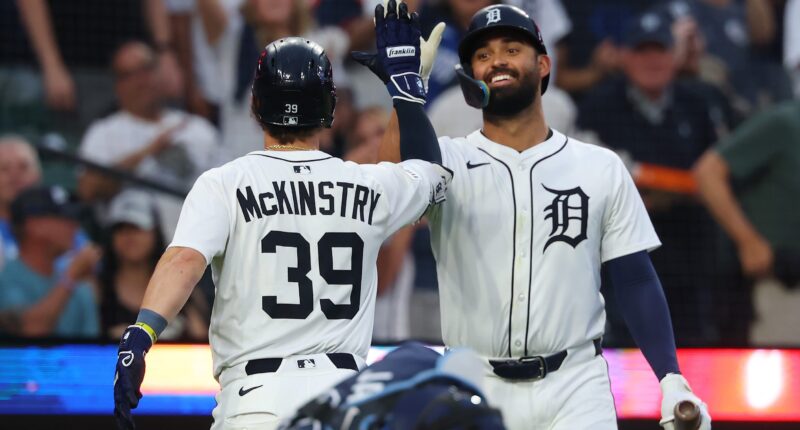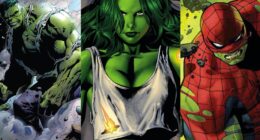
Getty
Zach McKinstry celebrates his seventh inning solo home run with Riley Greene while playing the Tampa Bay Rays at Comerica Park on July 07, 2025.
The Detroit Tigers didn’t just hit more home runs in 2025–they hit their stride as a lineup with identity. On Friday night, that growth got national attention when Riley Greene and Zach McKinstry both walked away with Silver Slugger Awards, recognizing the American League’s best offensive players at their positions. Greene claimed his first as an outfielder, while McKinstry stunned the league by taking the trophy as the top utilityman.
For a club that’s spent the past few years chasing stability, these two couldn’t have arrived at the right time. Greene, the former first-round prodigy, and McKinstry, the late-bloomer grinder, represent two ends of Detroit’s story–youth and persistence meeting in the same batter’s box of achievement.
Greene Arrives as the Real Deal
There was never any question that Greene could hit. The question was how long it would take for that talent to translate into sustained production. In 2025, he finally delivered the season that hinted at star power, and the league took notice. Greene finished with 36 home runs and a .258/.313/.493 slash line, good for a 121 wRC+.
He ranked tied for tenth in the majors in long balls, trailing only heavy hitters like Aaron Judge, Juan Soto, and Jo Adell among outfielders. Those numbers alone were enough to put him in Silver Slugger territory, but it was the first half of the season that truly turned heads.
Through mid-July, Greene was scorching pitchers: .284 average, 24 home runs, 21 doubles, and 78 RBIs before the All-Star break. He was driving everything (fastballs, breaking balls, inside pitches) with violent consistency. Then, the grind of a long season caught up. His second-half decline sparked questions about durability and a possible lingering physical issue, but the total body of work still screamed “breakout.”
At just 25, Greene has already proven he can be a lineup-anchoring power bat. Now the challenge is converting that first-half dominance into a full-season rhythm–the kind of consistency that turns potential into legacy.
McKinstry’s Career-Year Curveball
If Greene’s award was expected, McKinstry’s Silver Slugger was the curveball nobody saw coming. At 30 years old and long considered a role player, McKinstry reinvented himself as Detroit’s Swiss-army knife, capable of handling any position and giving the lineup competitive at-bats every night.
His final numbers, .259/.333/.438, 12 homers, and 19 stolen bases, only tell part of the story. The first half was the real revelation: a .285 average and .364 OBP with eight home runs, 14 doubles, and an eye-popping eight triples. That stretch gave the Tigers something they’d been missing–a table-setter who could also burn a pitcher for mistakes.
Then came the cooling period. McKinstry’s second-half numbers fell to .213/.278/.378, a return closer to his career baseline. But when the votes came in, his full-season contributions as a versatile spark plug stood tall.
For a player who spent his twenties bouncing between teams and depth charts, this Silver Slugger feels like validation–a reward for the daily grind of a blue-collar big leaguer who never stopped finding ways to stay useful.
Offense With an Identity
Greene and McKinstry’s awards share a deeper significance for Detroit. For years, the Tigers’ offense has been in search of a core, a lineup with punch and personality. These two performances hint that the pieces are starting to align. Greene gives Detroit a legitimate middle-order bat who can change games with one swing. McKinstry provides versatility and competitive energy that makes a team harder to play against.
More importantly, their success wasn’t a fluke built on luck or one-month hot streaks; it came from identifiable, sustainable improvements. Greene learned to lift the ball more effectively to his pull side, while McKinstry improved his plate discipline and contact rate against left-handers. Both adjustments paid off, and both give the Tigers a model for what their offensive identity could be: disciplined aggression, athleticism, and adaptability.
Alyssa Polczynski Alyssa Polczynski is a multimedia journalist covering Major League Baseball for Heavy.com. She has experience as an editorial producer for MLB.com and contributed to the Society for American Baseball Research (SABR). More about Alyssa Polczynski
More Heavy on Tigers
Loading more stories









